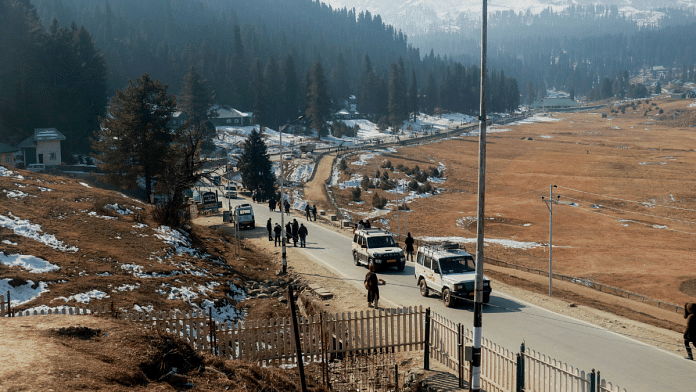New Delhi: With the absence of snow in Gulmarg and the rest of Kashmir leaving tourists and local residents disappointed, weather experts have attributed the situation to an interplay of El Niño and climate change, which has led to warmer temperatures and no precipitations in Kashmir.
El Niño, a global weather phenomenon characterised by warmer-than-average sea surface temperatures in the Pacific Ocean, influences weather patterns across the world. In India, it affects the monsoon system, leading to reduced rainfall in some parts of the country and a deluge in others.
For instance, North India saw the driest August in a century last year. This happened even while Uttarakhand and Himachal Pradesh witnessed devastating landslides due to the heavy rains.
This too was a consequence of the effects of El Niño coupled with climate change.
It’s for this reason that, according to experts, areas like Gulmarg, a popular ski resort in the Pir Panjal Range of the Himalayas, have been unusually dry this year. The area, which, according to weather portal World Weather Online, typically sees an average of 130.61 cm of snow in January, is yet to see any snow this year.
“The whole of December and the first week of January has been dry,” news agency ANI quoted Mukhtar Ahmad, director of IMD’s Meteorological Centre, Srinagar, as saying earlier this month.
Also Read: Why north India is seeing March-like temperatures in February
Why it snows in Kashmir and what happened this year
The snowfall in Kashmir during the first week of January is a result of a combination of factors, the primary factor being western disturbances — storms of moisture-laden air that originate over the Mediterranean Sea and travel eastward across the Middle East and Iran before reaching the Indian subcontinent.
As these disturbances approach the Himalayas, the moist air is forced upwards, and as it rises, it cools down and condenses, forming clouds. These clouds eventually precipitate as snow, especially over the higher reaches of Kashmir.
During the peak winter month of January, temperatures are typically below freezing point in Kashmir, especially in higher altitudes areas such as Gulmarg. These cold temperatures ensure that the precipitation falls as snow rather than rain, even at lower elevations.
This is not the first time that Kashmir has not received snowfall. Data shared by the Meteorological Centre Leh-Ladakh shows that 2016 and 1998 were also dry years for the Gulmarg.
“This is definitely uncommon but not something that hasn’t happened before. The main cause is that there have been weak western disturbances,” Soma Sen Roy, a scientist at the India Meteorological Department, told ThePrint. “This means they brought less moisture from the Arabian Sea and that led to less precipitation. The continuing effect of El Niño is another reason.”
Although the moisture-laden winds originate in the Mediterranean, if the amplitude of the western disturbance is high enough, it also pulls moisture from the Arabian Sea, Roy said.
Shresth Tayal, senior research fellow at Delhi-based The Energy and Resources Institute (TERI), explains that because of El Niño and global warming, the entire circulation pattern has been affected.
“The conditions that would have led to strong western disturbances originating in the Mediterranean did not take place,” Tayal told ThePrint.
The effects of El Niño usually stretch over a couple of years, Tayal said, adding that this is the reason why Himachal received little snowfall last year too. Sonam Lotus, former chief engineer of IMD, J&K division, said what’s worrying is that it’s warmer than usual this year.
“The wind isn’t as icy as it used to be,” Sonam Lotus, a meteorologist and Former chief engineer of IMD, J&K division, told ThePrint. “But such fluctuations in precipitation and temperature aren’t uncommon. We’ve seen them before in the Himalayas history.”
Tayal however said that the climate crisis and global warming are exacerbating the changes in weather patterns in the region. The climate crisis will make weather erratic and unpredictable, he said.
“This (lack of snow this year) does not mean that we will continue to see less snowfall in the coming years — it might be that next year we end up seeing extreme snowfall,” he said.
Impact of reduced snowfall — water availability, apple cultivation
The lack of snowfall has heavily affected tourism in Gulmarg, but the changing snowfall patterns may also have other consequences, such as its impact on the availability of water in the region.
Melting glaciers and snow form the primary source of water in the Indo-Gangetic plains. In Himachal, for instance, melted snow turns into the many crisscrossing springs.
According to Tayal, reduced snowfall could affect these springs. Snow also has an impact on apple cultivation both in Kashmir and in Himachal Pradesh, he told ThePrint.
“The ripening of apples depends on the snowfall. The quality as well as the yield is likely to be affected this year,” he said.
(Edited by Uttara Ramaswamy)
Also Read: 82% Indians ‘alarmed’ or ‘concerned’ about global warming, says Yale-CVoter survey



